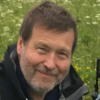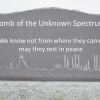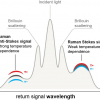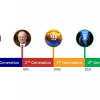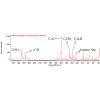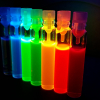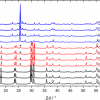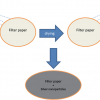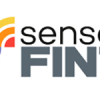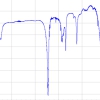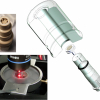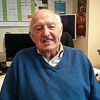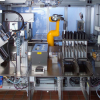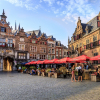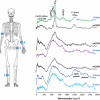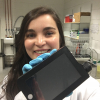Articles
Under the direction of Editor and Publisher Ian Michael, Spectroscopy Europe, and Spectroscopy World, have been writing about the latest trends in analytical sciences since 1975.
Tony considers the “Life and death of a data set: a forensic investigation”. Over time, spectral data will become increasingly fragmented and lose important supporting information. Computer and software upgrades, and processing in chemometric programs can all cause this. Of course, the answer is to follow FAIR principles and ensure that they are implemented in the analytical laboratory.
This article describes a really interesting use of spectroscopic data processing from optical fibre cables.
John Hammond finishes his magnum opus on “Four Generations of Quality” with a look at what is science fiction and what is science fact. He considers what may turn out to be “fact” in the future for each of the preceding eight articles in the series.
A Raman spectroscopy method was optimised to examine the chemical changes of aspirin tablets after interaction with helium temperatures.
Tony Davies has started a timeline of significant spectroscopic system developments aligned with Queen Elizabeth’s reign as recently celebrated in her Platinum Jubilee. Jumping from Princess Anne the Princess Royal’s birth to Heinrich Kaiser certainly makes for a novel approach! Tony hopes that we can turn this into an online resource with your help.
This article looks at three related spectroscopic techniques/tools in the toolbox, namely, Fluorescence, near infrared (NIR) and Raman; and discuss the “what”, “where” and “how” of these techniques are being used to improve the quality of the measurement processes associated with them.
Holger Gibhardt, Fabian Ziegler and Götz Eckold tell us about the use of Raman spectroscopy to understand complex electric and magnetic interactions in multiferroic ionic crystals. Multiferroics are a relatively new class of materials that exhibit magnetic and electrical ordering simultaneously. Both phenomena are coupled so that electric forces may be used to control the magnetic structure and vice versa. Raman enables understanding of the underlying processes on the atomic level, essential for the development of new materials with these properties.
Surface-enhanced Raman spectroscopy for selected energetic material detection is the topic of Mohamed Mokhtar, Tamer Wafy and Mahmoud Abdelhafiz. They have investigated various approaches to improve the SERS response of explosive materials and have come up with a simpler, one-step method for the detection of natural, solid TNT.
The SensorFINT COST Action is a European Network for assuring food integrity using non-destructive spectral sensors.
Following our articles on the FAIR initiative, we now look at some examples of the FAIRification of data handling, collection and archiving.
The Tony Davies Column offers a challenge to us all with another contribution on FAIR data, which should be Findable, Available, Interoperable and Readable. It is clearly the way we should all be going, everybody from manufacturers and software developers, through researchers to publishers needs to work together.
How did a major trade show organiser cope with the disruption of COVID-19? Susanne Grödl, Exhibition Director of analytica for Messe München, gives her experience.
A look at recent advances in the use of Raman spectroscopy in the nuclear industry.
Peter McIntyre and Tony Davies remember Bill George, a real Welsh character and educator whose style and charisma influenced many to go on and not only stay in science but to rise to leading positions either in industry or academia.
In quantitative analysis, is it better to weigh materials when making up standard solutions or to use volumetric techniques? Traditionally, the answer has been “volume”, however, things may not be as straightforward as they seem. Henk-Jan and colleagues have conducted a new experiment, using robots for both sample preparation and spectroscopic analysis which may provide a definitive answer. Unfortunately, the answer must wait for publication of their paper, but Tony and Henk-Jan’s history of this question makes interesting reading nevertheless.
With a significant proportion of our regular readership probably under home lock-down, we were wondering if we could help you at this difficult time by pointing out some useful online resources. So, when we finally come out of this pandemic, you could do so better skilled and more up-to-date than when we went in to it.
Tony and Lutgarde Buydens give us an update on the planning for the major EuroAnalysis 2021 conference, which is being held in Nijmegen, the Netherlands, at the end of August 2021. At this stage, they are keen to gather suggestions from readers on topics they would like to see covered. Groups are also invited to consider hosting their own event under the EuroAnalysis 2021 banner.
Burned bones are often found in archaeological sites as a result of fire or funerary practices and are often the only preserved human remains. Using inelastic neutron scattering, infrared and micro-Raman spectroscopies, the authors can reach definitive conclusions as to the temperature at which the bone was burned. This enables archaeologists and anthropologists to learn more about how ancient civilisations used fire for funerary, burial or cooking purposes.
An interesting insight into, well, a week in the life of the author as a fourth-year PhD student. Katie is working on investigating a way of detecting liver damage using spectroscopy, which is “about as interdisciplinary as you can get”! I’m sure all readers will find it interesting and it may be helpful for those you know who may be considering a PhD.

